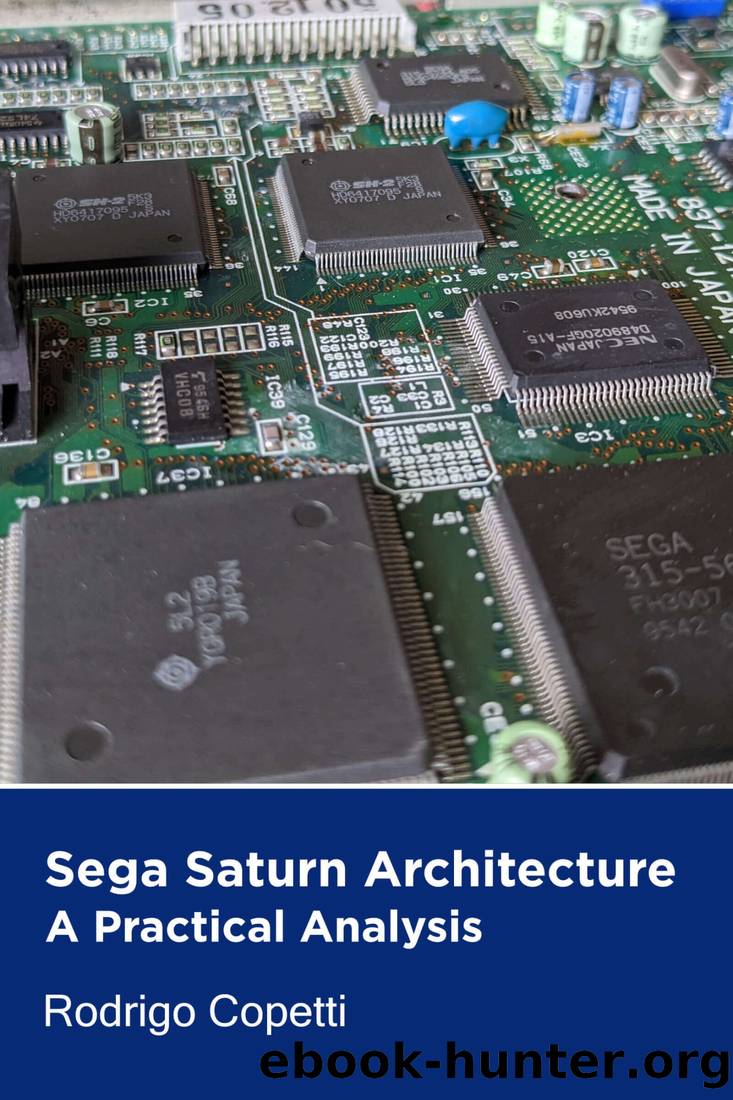Sega Saturn Architecture: What Can You Do With 8 Processors? by Rodrigo Copetti

Author:Rodrigo Copetti [Copetti, Rodrigo]
Language: eng
Format: epub
Tags: Nonfiction, Computers, Advanced Computing, Engineering, Computer Architecture, Application Software, Computer Graphics, Computer Science
ISBN: 9798201361051
Published: 2019-08-02T16:30:00+00:00
5.7 The transparency issue
The Sega Saturn is capable of drawing half-transparent graphics, in other words, mixing overlapping layers of colours (blending) to give the illusion we can see through them. Unfortunately, both VDPs arenât as coordinated as one would expect, so this effect will not work properly when these layers are found in different VDPs.
As a workaround, games can activate the âmeshâ property on a texture. With âmeshedâ textures, the VDP1 sets the odd X/Y texture coordinates as âtransparentâ (empty). Making it possible to blend other layers using the transparent pixels. Curiously enough, the mesh would appear blurred if the console was connected to the TV using the composite video signal (which was pretty much the standard back then, aside from RF) resulting in an accidental but effective way to accomplish half-transparency [12].
As you may suspect, this just wasnât viable for some games, so in the end, these had no option but to ditch half-transparency altogether⦠Although some studios found ingenious fixes, take a look at these two cases:
Figure 5.13: Segaâs Daytona (1993). Interactive viewer available in the website edition.
Download
This site does not store any files on its server. We only index and link to content provided by other sites. Please contact the content providers to delete copyright contents if any and email us, we'll remove relevant links or contents immediately.
| AI & Machine Learning | Bioinformatics |
| Computer Simulation | Cybernetics |
| Human-Computer Interaction | Information Theory |
| Robotics | Systems Analysis & Design |
Algorithms of the Intelligent Web by Haralambos Marmanis;Dmitry Babenko(16235)
Jquery UI in Action : Master the concepts Of Jquery UI: A Step By Step Approach by ANMOL GOYAL(9387)
Test-Driven Development with Java by Alan Mellor(7735)
Data Augmentation with Python by Duc Haba(7609)
Principles of Data Fabric by Sonia Mezzetta(7378)
Learn Blender Simulations the Right Way by Stephen Pearson(7294)
Microservices with Spring Boot 3 and Spring Cloud by Magnus Larsson(7137)
Hadoop in Practice by Alex Holmes(6587)
RPA Solution Architect's Handbook by Sachin Sahgal(6516)
The Infinite Retina by Robert Scoble Irena Cronin(6216)
Big Data Analysis with Python by Ivan Marin(5934)
Life 3.0: Being Human in the Age of Artificial Intelligence by Tegmark Max(5516)
Pretrain Vision and Large Language Models in Python by Emily Webber(4894)
Infrastructure as Code for Beginners by Russ McKendrick(4653)
Functional Programming in JavaScript by Mantyla Dan(4436)
WordPress Plugin Development Cookbook by Yannick Lefebvre(4382)
The Age of Surveillance Capitalism by Shoshana Zuboff(4245)
Embracing Microservices Design by Ovais Mehboob Ahmed Khan Nabil Siddiqui and Timothy Oleson(4148)
Applied Machine Learning for Healthcare and Life Sciences Using AWS by Ujjwal Ratan(4135)
